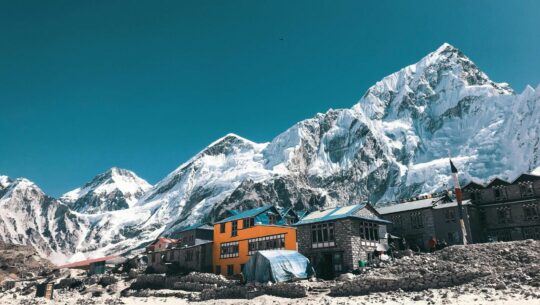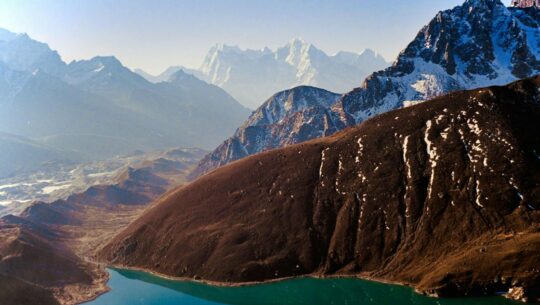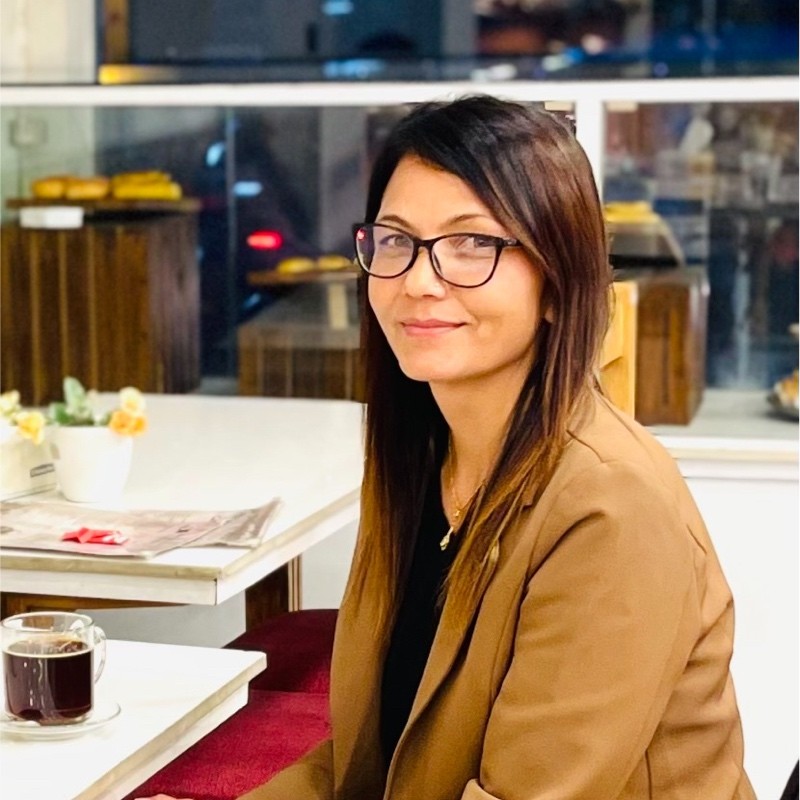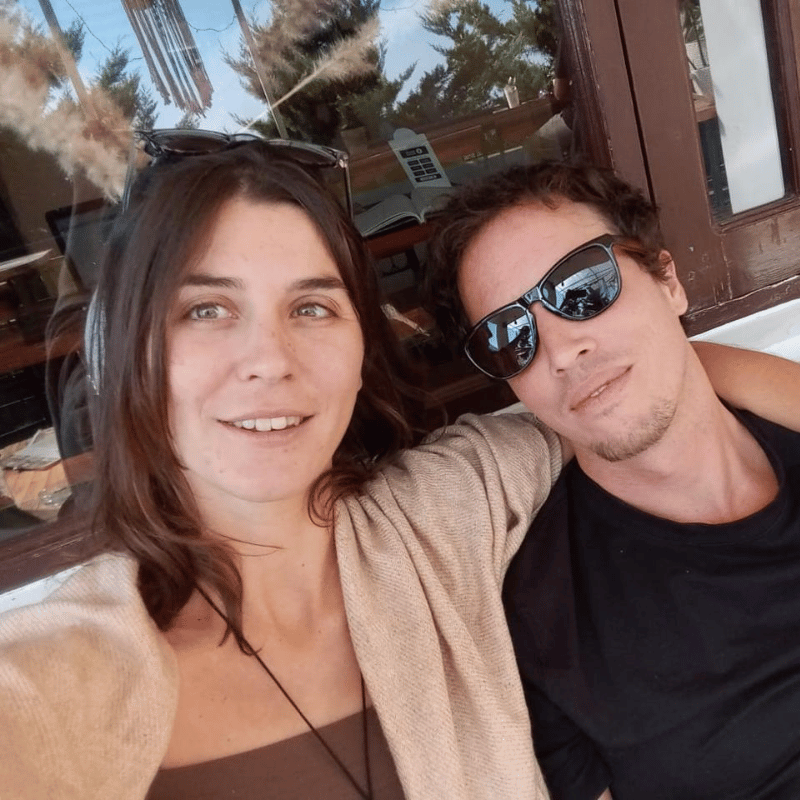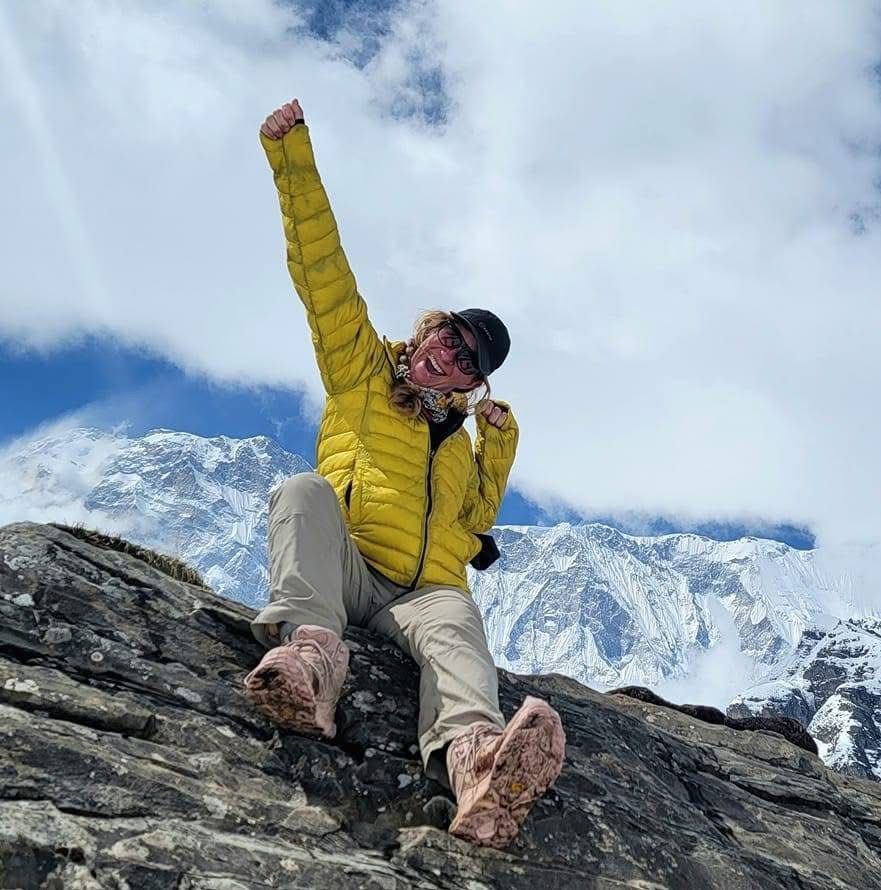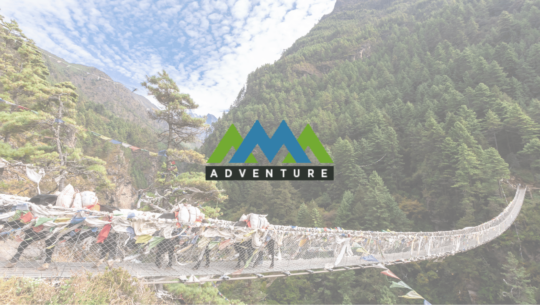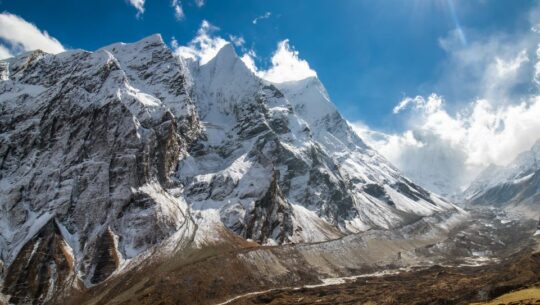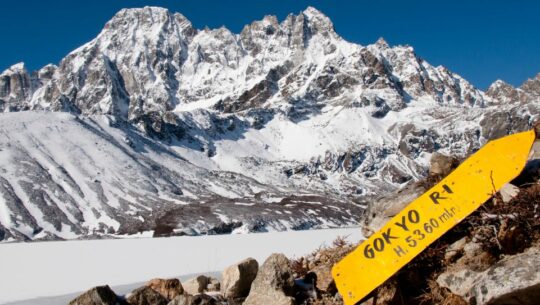
Gokyo Lake Trek- 14 Days
The Gokyo Lake Trek leads you to the beautiful Gokyo Lakes and then takes you up to Gokyo Ri, where you’ll be rewarded with stunning views of Everest, Cho Oyu, Makalu, and the Ngozumpa Glacier.
Nepal
14 Days
Strenious
5,483 m/17,988 ft
Mar- May, Sep - Nov
Hotel and Tea House
Included
Kathmandu
Trip Highlights
- Hike to the stunning Gokyo Lakes, tucked away in the heart of the Himalayas.
- Immerse yourself in the vibrant culture and deep traditions of the Sherpa people.
- Explore Namche Bazaar, where ancient customs blend seamlessly with modern mountain life.
- Take in the peaceful and picturesque scenery of the Gokyo Lakes along the way.
- Reach the summit of Gokyo Ri at 5,483 meters for a truly remarkable experience.
- From Gokyo Ri, enjoy breathtaking views of Everest, Cho Oyu, Makalu, and the Ngozumpa Glacier.
Trip Overview
The Gokyo Lake trek is a famous adventure known for its stunning views and rich cultural encounters. Along the way, you’ll enjoy spectacular panoramas of some of Nepal’s most iconic peaks over 8,000 meters, including Cho Oyu, Everest, Lhotse, and Makalu.
A key highlight of the Gokyo Lakes trek is the breathtaking view from Gokyo Ri, which stands above the Gokyo Lakes. From this vantage point, trekkers are rewarded with a stunning view of the massive ice ridge between Cho Oyu and Gyachung (2,922 meters) in the Khumbu region, along with expansive views of the Ngozumpa Glacier, the largest glacier in Nepal’s Himalayas.
The adventure begins with an exciting flight to Lukla, marking the start of the journey into the heart of the Himalayas.
In the days that follow, we trek through breathtaking landscapes, staying in local lodges and connecting with the friendly Sherpa community. This experience offers a chance to fully immerse yourself in the region’s natural beauty and rich cultural heritage.
Our Gokyo Lake trek is carefully planned with the help of experienced Sherpa guides who prioritize our safety while sharing their knowledge of the local customs and traditions.
As we trek, we pass by ancient Buddhist monasteries and get closer views of Everest and other majestic, snow-capped peaks.
Acclimatization is an important part of the journey, so we take several rest days in Namche Bazaar. These days give us the chance to explore the lively village and its surroundings, while also helping our bodies adjust to the higher altitudes, ensuring a safe and enjoyable trek.
After reaching the top of Gokyo Ri at 5,483 meters, we descend at a comfortable pace, retracing our path through the villages of Namche and Lukla before flying back to Kathmandu.
The Gokyo Lake trek provides a perfect mix of stunning natural landscapes and rich cultural experiences, making it an adventure you’ll never forget.
Outline Itinerary
- Day 1: Arrive at Tribhuvan International Airport in Kathmandu and transfer to the hotel
- Day 2: First Meeting and Swayambhunath Temple Tour
- Day 3: Fly from Kathmandu to Lukla (2,840 m/ 9,315 ft): a 35-minute flight, or take a 5-6 hr drive to Manthali/Ramechhap (474 m/ 1,558 ft) by a shared tourist vehicle, followed by a 20-mins flight to Lukla. From there, trek to Phakding (2,610 m/ 8,563 ft) for 3-4 hrs
- Day 4: Trek from Phakding to Namche Bazaar (3,440 m/ 11,286 ft): 5-6 hrs
- Day 5: Acclimatization day in Namche Bazaar. Hike to the Everest View Hotel (3,880 m/ 12,729 ft) and return
- Day 6: Trek from Namche Bazaar to Phorste Thanga (3,680 m/ 12,073 ft): 5-6 hrs
- Day 7: Trek from Phorste Thanga to Machherma (4,470 m/ 14,663 ft): 5-6 hrs
- Day 8: Trek from Machherma to Gokyo (4,800 m/ 15,748 ft): 5-6 hrs
- Day 9: Trek to Gokyo Ri (5,483 m) and Back to Gokyo: 5-6 hrs
- Day 10: Trek to Dole (4,200 m) from Gokyo: 6-7 hrs
- Day 11: Trek to Namche Bazaar (3,440 m) from Dole via Khumjung village (3,780 m): 5-6 hrs
- Day 12: Trek to Lukla (2,840 m) from Namche Bazaar: 6-7 hrs
- Day 13: Fly back to Kathmandu or Manthali/Ramechha from Lukla and drive back to Kathmandu
- Day 14: Transfer to the International Airport for your final departure
Detailed Itinerary
Day 1: Arrive at Tribhuvan International Airport in Kathmandu and transfer to the hotel
Upon your arrival at Tribhuvan International Airport in Kathmandu, one of our representatives will welcome you. You will be transferred to your hotel in a private tourist vehicle. In the afternoon, we will have a pre-trip meeting at our office with the trekking guide.
Overnight in Kathmandu.
Max Altitude
: Kathmandu (1,400 m)
Meals
: Not Included
Overnight
: Kathmandu
Accomodation
: Hotel
Day 2: First Meeting and Swayambhunath Temple Tour
On the second day of your trip, we will begin with a pre-trip meeting at 9 am at our office. During this meeting, you’ll meet your guide, go over the trekking itinerary, and check your gear to ensure you’re fully prepared for the trek ahead. Please bring two passport-sized photos and a clear copy of your travel insurance policy to complete the necessary documentation for the trek permits.
Following the meeting, we will head to Swayambhunath Temple (Monkey Temple) for a guided tour. This sacred site offers stunning views of the Kathmandu Valley and is an important cultural landmark.
By the end of the day, you’ll be ready for your trek and all preparations for your Lukla/Manthali flight will be complete.
Meals
: Breakfast
Overnight
: Kathmandu
Accomodation
: Hotel
Day 3: Fly from Kathmandu to Lukla (2,840 m/ 9,315 ft): a 35-minute flight, or take a 5-6 hr drive to Manthali/Ramechhap (474 m/ 1,558 ft) by a shared tourist vehicle, followed by a 20-mins flight to Lukla. From there, trek to Phakding (2,610 m/ 8,563 ft) for 3-4 hrs
During peak seasons, including March, April, May, September, October, and November, flights to Lukla will operate from Ramechhap/Manthali due to air traffic limitations in Kathmandu. The Manthali Airport is located about a 5 to 6-hour drive from Kathmandu. On the day of the flight, we will wake up early, between 1:00 AM and 3:00 AM, and take a shared tourist vehicle to Manthali Airport. From there, we’ll catch a 20-minute flight to Lukla.
Flights from Kathmandu to Lukla generally operate during the off-peak months, including January, February, June, July, August, and December. The decision to run flights is determined by the airline and depends on the number of travelers during each month. On the day of your flight, you will wake up between 5:00 AM and 6:00 AM. Our staff will guide you to the domestic terminal at Kathmandu airport, where you will take a 35-minute flight to Lukla.
Helicopter Option
You can choose to book a direct helicopter flight from Kathmandu to Lukla for an additional cost of USD 550 per person. This price is based on five people sharing the flight. It’s a great option to skip the long drive to Manthali airport, especially during the busy peak seasons of March, April, May, October, and November.
Flights to Tenzing-Hillary Airport usually depart early in the morning. We recommend sorting and packing everything the day before, so you can avoid any rush on Day 2. Once you arrive in Lukla, enjoy your breakfast while our guide arranges porters for you.
We provide one porter for every two clients. The trek begins with a descent towards the Dudh Kosi River, where you’ll join the main trail to Namche Bazaar, just above Chaunikharka (2,713 m). The walk is easy, and after passing through the small village of Ghat (2,550 m), it’s a short walk to Phakding.
Max Altitude
: Phakding (2,610 m)
Trip Duration
: 35 mins flight from ktm or 5-6 hrs drive & 20 min flight from Manthali, 3-4 hrs trek
Meals
: Breakfast, Lunch and Dinner
Overnight
: Phakding
Accomodation
: Teahouse
Day 4: Trek from Phakding to Namche Bazaar (3,440 m/ 11,286 ft): 5-6 hrs
We continue our trek along the Dudh Kosi River, crossing it multiple times on thrilling suspension bridges decorated with colorful prayer flags.
Once we enter the Sagarmatha National Park, the trail steepens, offering stunning views along the way. Namche Bazaar, known as the Gateway to Everest, is a lively town with a variety of restaurants, hotels, lodges, shops, currency exchange services, internet cafes, and bakeries. It is the largest town on the Everest trekking route.
Max Altitude
: Namche Bazaar (3,440 m)
Trip Duration
: 5-6 hrs trek
Meals
: Breakfast, Lunch and Dinner
Overnight
: Namche Bazaar
Accomodation
: Teahouse
Day 5: Acclimatization day in Namche Bazaar. Hike to the Everest View Hotel (3,880 m/ 12,729 ft) and return
We spend the day in Namche Bazaar to help our bodies adjust to the higher altitude. We’ll take a short trek to a museum known for its displays of Sherpa culture and traditions.
We’ll also hike up to the Syangboche Airport near the Everest View Hotel. From here, we’ll enjoy breathtaking views of the Himalayas, with a stunning sunrise and sunset over the Khumbu peaks.
Max Altitude
: Everest View Hotel (3,880 m)
Meals
: Breakfast, Lunch and Dinner
Overnight
: Namche Bazaar
Accomodation
: Teahouse
Day 6: Trek from Namche Bazaar to Phorste Thanga (3,680 m/ 12,073 ft): 5-6 hrs
The trail climbs sharply out of the valley, winding through rhododendron forests. As you gain altitude, juniper and tall conifer trees begin to appear, creating a refreshing and peaceful atmosphere, especially beautiful during the spring bloom.
You’ll pass through yak pastures and seasonal herder settlements along the way. The views of Khumbi La and Tawache peaks remain stunning throughout the day.
Max Altitude
: Phorste Thanga (3,680 m/ 12,073 ft)
Trip Duration
: 5-6 hrs
Meals
: Breakfast, Lunch, and Dinner
Overnight
: Phorste Thanga
Accomodation
: Teahouse
Day 7: Trek from Phorste Thanga to Machherma (4,470 m/ 14,663 ft): 5-6 hrs
We begin the day with a steady climb up a ridge that offers wide views-down the valley towards Kengtega and up towards the towering Cho Oyu. The trail then descends to a river before rising again on a steep path that leads to the terminal moraine of the Ngozumpa Glacier. We reach the village of Machherma by early noon.
Max Altitude
: Machherma (4,470 m)
Trip Duration
: 5-6 hrs trek
Meals
: Breakfast, Lunch and Dinner
Overnight
: Machherma
Accomodation
: Teahouse
Day 8: Trek from Machherma to Gokyo (4,800 m/ 15,748 ft): 5-6 hrs
Today’s trek takes us to one of our main destinations, Gokyo (4,800m). We will set up camp here for two nights, allowing time for sightseeing and hiking around the Gokyo area.
Max Altitude
: Gokyo (4,800 m)
Trip Duration
: 5-6 hrs trek
Meals
: Breakfast, Lunch and Dinner
Overnight
: Gokyo
Accomodation
: Teahouse
Day 9: Trek to Gokyo Ri (5,483 m) and Back to Gokyo: 5-6 hrs
Early in the morning, we have a steep climb up to the top of Gokyo Ri at an elevation of 5,483m, it is one of the best viewpoints in the Everest region .
There are ample rewards for those who attempt this trip – you get stunning views of the super Gokyo valley, the massive Ngozumpa glacier and an incredible panoramic view of the whole Khumbu Himalayas, including the giants Everest, Lhotse, Nuptse, Makalu, Cho-Oyu and Gychung Kang.
Max Altitude
: Gokyo Ri (5,483 m)
Trip Duration
: 5-6 hrs trek
Meals
: Breakfast, Lunch and Dinner
Overnight
: Gokyo
Accomodation
: Teahouse
Day 10: Trek to Dole (4,200 m) from Gokyo: 6-7 hrs
Today, we begin our descent from Gokyo, retracing our steps along the trail to the charming village of Dole. As we descend, we’ll pass through lush forests and scenic landscapes, with stunning views of the Himalayas fading behind us.
Arriving in Dole, we’ll settle into a guesthouse for the night, enjoying the serene atmosphere and preparing for the next leg of our journey.
Max Altitude
: Dole (4,200 m)
Trip Duration
: 6-7 hrs trek
Meals
: Breakfast, Lunch and Dinner
Overnight
: Dole
Accomodation
: Teahouse
Day 11: Trek to Namche Bazaar (3,440 m) from Dole via Khumjung village (3,780 m): 5-6 hrs
We continue walking through a typical Sherpa village of Khumjung, leaving the mountains behind us as we descend back to Namche Bazaar.
Max Altitude
: Namche Bazaar (3,440 m)
Trip Duration
: 5-6 hrs trek
Meals
: Breakfast, Lunch and Dinner
Overnight
: Namche Bazaar
Accomodation
: Teahouse
Day 12: Trek to Lukla (2,840 m) from Namche Bazaar: 6-7 hrs
Today, we make our way back to Lukla, where our trek began, which may feel like it was a long time ago. We’ll take some time to relax and reflect on the journey as a group, celebrating the personal achievements of everyone who joined the trek. There will also be some free time to explore the town before we wrap up our adventure.
Max Altitude
: Lukla (2,840 m)
Trip Duration
: 6-7 hrs trek
Meals
: Breakfast, Lunch and Dinner
Overnight
: Namche Bazaar
Accomodation
: Teahouse
Day 13: Fly back to Kathmandu or Manthali/Ramechha from Lukla and drive back to Kathmandu
Lukla to Manthali Flight (March, April, May, October, and November):
The flight from Lukla to Manthali takes about 20 minutes. From there, it’s a 5 to 6-hour drive to Kathmandu, depending on the traffic conditions. You will be transferred to your hotel in Kathmandu by a shared tourist vehicle.
Lukla to Kathmandu Flight (January, February, June, July, August, September, and December):
The flight from Lukla to Kathmandu lasts around 35 minutes. Upon arrival, you’ll be transferred to your hotel in Kathmandu via a shared tourist vehicle. Please note that flight operations depend on the airline and the number of travelers during the particular month.
In the evening, we will host a farewell dinner at a nice restaurant.
Helicopter Option
You have the option to book a direct helicopter flight from Lukla to Kathmandu for an extra charge of USD 550 per person. This price is quoted on a 5-people sharing basis. This is the best alternative to avoid the long drive to from Manthali airport to Kathmandu during peak season (March, April, May, October and November).
Accomodation
: Hotel
Day 14: Transfer to the International Airport for your final departure
The trip comes to an end today. Our airport representative will escort you to Tribhuwan International Airport in Kathmandu for your flight departure from Nepal.
Important Note on Itinerary and Lukla Flights
Our regular itinerary may change slightly due to factors beyond our control, such as weather conditions, flight delays or cancellations, natural events, government regulations, political issues, or health concerns. In such situations, we always work to find the best possible alternatives to keep the trek moving forward. Your patience and flexibility during these times are greatly appreciated.
We highly recommend adding at least two extra days to your schedule after the trek. Flights to and from Lukla are often delayed or canceled due to weather, and these buffer days help avoid issues with your international travel plans. You can also choose to customize your trip with extra sightseeing in Kathmandu, adventure activities, or short trips around Nepal before or after the trek.
Lukla Flight Update
Please note: During peak trekking seasons (March, April, May, September, October, and November), flights to Lukla operate from Ramechhap/Manthali Airport, which requires a 5-6 hour drive from Kathmandu due to heavy air traffic. In non-peak months (January, February, June, July, August, and December), flights usually depart directly from Kathmandu.
The choice of departure point is made by the airline and depends on travel volume at the time. Weather, air traffic, and the challenging terrain around Lukla are the main reasons for flight delays or cancellations. Adding a day or two to your itinerary gives you a cushion in case of such disruptions and helps ensure a smooth return for your international flight.
Gallery
What is included
Accommodation
- 4-star hotel in Kathmandu on a twin/double-sharing basis with breakfast
- Guesthouses during the trek (twin-sharing), with attached toilets in Lukla, Phakding, and Namche
Meals & Drinking Water
- Breakfast, Lunch, and Dinner during the trek
- One hot drink per meal and seasonal fruits
- Farewell dinner on the final night in Nepal
- Purified drinking water throughout the trek (via water filter or purification tablets)
Transportation
- All airport transfers (domestic) by private tourist vehicle
- Kathmandu to Manthali by shared tourist vehicle
- Round-trip airfare between Kathmandu/Manthali and Lukla
Guide & Support Staff
- Licensed, experienced, English-speaking trekking guide (2 guides for groups of 8 or more)
- Porter support (1 porter per 2 clients)
- All staff’s wages, accommodation, meals, insurance, gear, and medication
Permits & Entry Fees
- Sagarmatha (Everest) National Park entry permit
- Pasang Lhamu Rural Municipality entrance fee
- TIMS (Trekkers’ Information Management System) card
Health & Safety
- Comprehensive first aid kit
- Daily health checks with a pulse oximeter to monitor altitude-related symptoms
Extras & Souvenirs
- Duffle/kit bag, and a trip completion certificate
Administrative
- All government taxes and administrative fees
What is Excluded
- Meals in Kathmandu – Lunch and dinner while in Kathmandu
- International airfare and airport departure tax
- Travel insurance – Must include high-altitude emergency evacuation coverage
- Alcoholic beverages, cold drinks, bottled juices, bottled and boiled water
- Tips – For trekking staff and drivers (at your discretion)
- Personal trekking gear and equipment
- Single room supplement – Available on request at an extra cost
- Any expenses not mentioned in the Price Includes section
- Nepal Entry Visa – Payable on arrival at Tribhuvan International Airport
Trip Departure
Ama Adventure arranges both solo and group travel, ensuring amazing experiences with people from all over the world. Before departure, we reconfirm the number of participants in your group. We guarantee all group departure dates even if there’s only one person signed up for the Gokyo Lake Trek. This ensures that your adventure is confirmed regardless of group size.
Difficulty Level
The 14-day Gokyo Lake Trek is a tough adventure meant for those in good shape. Though it doesn’t need any climbing skills, the trail involves steep climbs and high-altitude hiking, reaching over 5,000 meters at Gokyo Ri. Trekkers walk 6 to 10 hours a day in thin air and cold weather, so stamina and mental strength are key. It’s best for those with some trekking experience, but fit first-timers can manage with proper preparation.
Dates & Price
We ensure departures on all published dates. If these dates don’t align with your plans, we’re happy to assist in setting a customized date. Whether you’re a solo traveler, a couple, a family, or a group seeking private trips, you can tailor-make your adventure. Reach out to us for pricing details or any other queries.
Meals
Throughout our trek, you’ll savor authentic Nepalese dishes alongside international cuisines such as Tibetan, Continental, Italian, and Indian. Breakfast and dinner will be served at the tea houses or lodge menus where we stay overnight, while lunches will be provided en route to our next destination. During the trek, all meals are included. In Kathmandu, breakfast is provided, and special welcome and farewell dinners will be arranged for our guests.
Accomodation
We’ll be accommodated at Hotel Manaslu in Kathmandu, and the best available teahouses during our trek. Accommodations are based on twin sharing. For those requesting a single room, there will be an additional cost of USD 100. While we aim for rooms with attached washrooms, please note that some tea houses may only have shared washing and toilet facilities. Single rooms are readily available in Kathmandu, and lower-elevation trekking areas, but availability might be limited at higher elevations.
Weather Information
The weather in the Everest region is unpredictable and can change quickly. One moment it might be sunny and warm, and the next, you could be walking through fog, rain, or chilly winds. It’s important to be ready for all kinds of conditions. Nights get especially cold compared to daytime, and temperatures can swing from around 25°C during the day to as low as –20°C at night.
Important Notes
You will receive a free duffel bag and baseball cap during your pre-trip meeting in Kathmandu. The duffel bag will be used to pack your trekking supplies.
1 porter for every 2 participants. The duffel bag (weighing 10kg/22lbs) will be carried by the porter during the trek.
You’ll need your own daypack (with a waterproof cover) for daily necessities such as cash, important documents, a water bottle, camera, toiletries, and sunscreen.
Storage available in Kathmandu: Non-trekking luggage can be stored at the hotel.
Luggage allowance for Kathmandu-Lukla flight: 15kg/33lbs (includes duffel 10kg/22lbs and backpack 5kg/11lbs).
Down jacket with a hood is a must for altitudes above 4,000m for warmth (Rental available for USD 35).
4-season sleeping bag is also essential for cold nights (Rental available for USD 35).
Note: Some clothing, especially form-fitting items made of elastic material (like yoga pants), may offend locals. If you choose to wear these clothes for comfort, make sure to wear something over them.
Packing List
Here’s a suggested packing list to help you get ready for the Gokyo Lake Trek- 14 Days. This list is a great starting point, but keep in mind that you’ll need layers of warmer clothing, especially during the winter. We will provide a 75-liter duffel bag for your trek. It will be given to you during your pre-trip meeting in Kathmandu, and it’s yours to keep. Additionally, you can rent a sleeping bag and down jacket from us for an extra fee of USD 35 each in Kathmandu.
General
- Four-season sleeping bag (rated to 0°C or lower)
- Sleeping bag liner
- Puffy down jacket
- Daypack (35-45 liters recommended) with rain cover
Upper Body
- Sun hat or cap
- Warm knitted hat or beanie
- Headlamp with extra batteries
- UV-protection sunglasses
- Scarf/Neck Gaiter/Buff (Highly recommended)
Torso
- Technical fabric base layer (light for warmer months, heavy for colder months)
- Technical fabric short (2) and long sleeve (2) shirts
- Waterproof, windproof shell
- Fleece jacket or pullover
Lower Body
- Technical fabric base layer (light for warmer months, heavy for colder months)
- Hiking pants (2 pairs)
- Comfortable pants for inside the teahouses
- Waterproof, windproof shell
- Hiking shorts
Hands
- Wool or technical fabric liner gloves
- Hard-shell outer gloves (insulated for colder months)
Feet
- Warm or technical fabric warm socks
- Hiking socks
- Optional liner socks (e.g., silk) for added comfort and blister prevention
- Waterproof trekking/hiking boots – well broken-in before the trek
- Ice Cleats or Micro Spikes (recommended from November to March for icy trails)
- Casual shoes or sandals
- Gaiters – lightweight for dust or heavier ones for snow in cold months
Undergarments
- Technical fabric/quick-drying underwear
- Sports bras (for women)
- Pajamas or sleepwear clothes
First Aid Kits and Medications
- Sunscreen (high SPF)
- Lip balm with SPF
- Antiseptic or soothing ointment
- Personal medications (for altitude, allergies, pain relief, etc.)
(Note: Our guides carry a basic first aid kit, but personal supplies are strongly recommended)
Other Essential Items
- Valid passport
- Extra passport-sized photos (for permits or emergency use)
- Airline tickets (leave a copy with our office in Kathmandu)
- Reusable water bottle or hydration bladder
- Water purification tablets or UV water purifier
- Lightweight towel
- Pillowcase (for hygiene in teahouses)
- Toiletry kit (toothbrush, toothpaste, wipes, etc.)
- Toilet paper (2 rolls minimum)
- High-protein snacks (nuts, energy/protein bars)
- Waterproof/dry bags to protect documents and valuables
Optional
- Guide Book
- Power bank or spare batteries
- Camera and mobile phone (for capturing memories)
- Cards, books, or lightweight entertainment
- Pee bottle or pee funnel (especially useful for women at high altitudes)
- Trekking poles (highly recommended for stability)
- Whistle (for safety/emergency use)
- Thermos (to carry hot water/tea during cold days)
Tip: Thamel is full of gear shops where you can purchase or rent trekking essentials at a reasonable price once you’re in Kathmandu.
Documents and Logistics
- Flight Information
- Original Passport
- Photocopy of Passport
- Passport size photo for Tims and permit (4)
- Medical Insurance Card
- Airline tickets (leave a copy with our office in Kathmandu)
Dates & Prices
We ensure departures on all published dates. If these dates don’t align with your plans, we’re happy to assist in setting a customized date. Whether you’re a solo traveler, a couple, a family, or a group seeking private trips, you can tailor-make your adventure. Reach out to us for pricing details or any other queries.
Group Discount Prices
Frequently Asked Questions
Traveler Reviews





